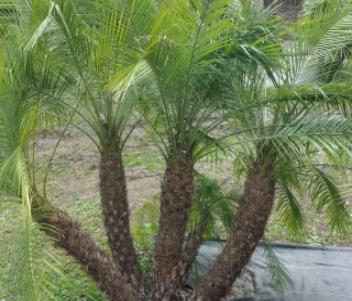Live Green, Love Green, Think Green
South Florida Landscape Plants
| Pygmy Date Palm Phoenix roebelenii Feathery fronds and small stature make the pygmy date palm one of South Florida's most popular landscape palms. Triple pygmy date palm with crotons and dwarf ixora in front of a home This beautiful, easy-care palm works almost anywhere as an accent plant for any size yard...even close to the house or by the pool. Naturally a solitary-trunk palm, it's most often seen with two, three or even four palms planted together to make a multi-trunk specimen. The additional trunks add fullness to its graceful form. A single-trunk pygmy takes up less room and generally grows straight up, making it a good choice for a narrow spot. One with double trunks can frame and showcase a focal point beyond it. Plant specs Slow-growing to an ultimate height of only about 12 feet, this outstanding little palm is generally cold hardy to Zone 9B (especially when planted in a protected spot). If winter brings very cold winds, the pygmy may show leaf-tip burn. It takes full sun to partial shade, making it easy to find a great planting location in the yard. Pygmy date palms are said to be deer-resistant, but we make no promises. Plant care Happily low-maintenance, a pygmy palm should be planted with top soil as a soil amendment, and fertilized with granular palm fertilizer in spring, summer and fall. Old fronds and occasional seed pods will form a brown "petticoat" under the greenery; trim them off now and then. Water on a regular basis. Plant spacing Plant at least 3 feet (4 or 5 would be even better) from the house, positioning the trunks of a multi-trunk specimen in a way that makes sense for future growth. Single trunk specimens can go as close as 3 feet. Triple-trunk palm beside house Pygmy palms can be grown in containers and work well in pool cage planters, since they grow so slowly and don't get too tall. Give this palm lots of light while in a container. Landscape uses for pygmy date palm by the entry in a pool-cage planter a fluffy companion plant between taller palms for privacy (moderate amount) in front of a window corner accent for the house or outside the pool cage anchor specimen in a garden bed single specimen for a small yard or area to give height and interest to a blank wall in the center of a circular drive patio or pool container plant accenting an architectural element of the house |

